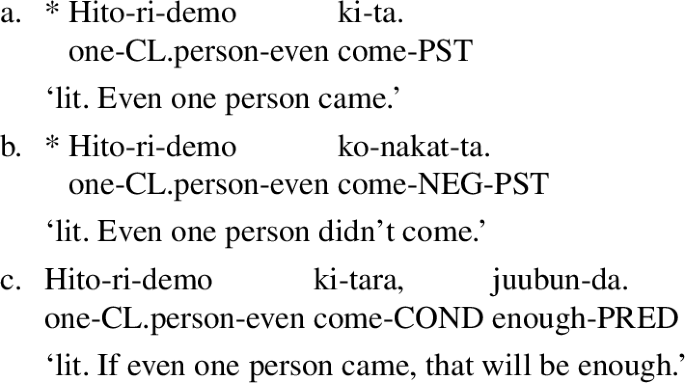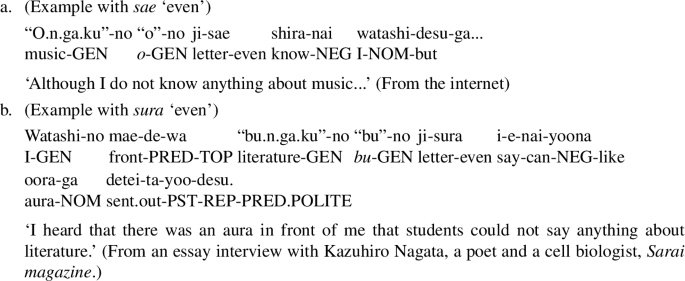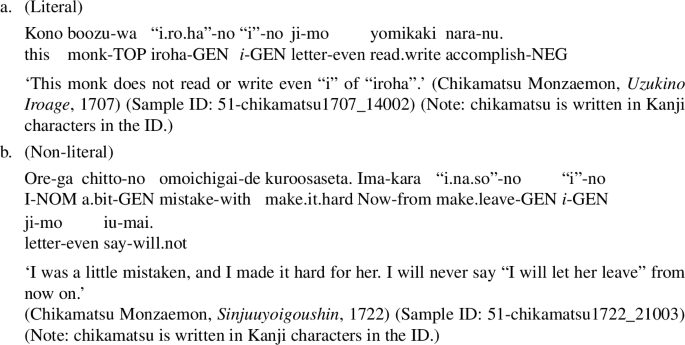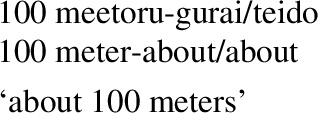Abstract
This study investigates interpretations of the Japanese initial mora-based minimizer “X.Y...”-no “X”-no ji-mo ‘lit. even the letter “X” of “X.Y...”.’ Although initial mora-based minimizers have a literal interpretation of ji ‘letter’, they have a non-literal interpretation as well. The non-literal interpretation has several distinctive features that are not present in ordinary minimizers. First, it is highly productive in that various expressions can appear in the form “X.Y...”-no “X”-no ji. Second, non-literal minimizers typically co-occur with predicates that relate to knowledge, information, concepts, thought, and habituality, as seen in the corpus data (Balanced Corpus of Contemporary Written Japanese [BCCWJ]).
I argue that in the non-literal use, X refers to the minimum on the scale of the main predicate concerning “X.Y...”. I suggest that the non-literal use was developed as a result of the conventionalization of the pragmatic inference derived from the literal reading, and that the co-occurrence with predicates related to knowledge, information, knowledge, concepts, thought, or habituality is due to the interpretation of “X.Y...”, which were originally interpreted as letters as an abstract concept.
The theoretical implication of this study is that, in addition to a non-compositional (lexically specified) minimizer whose scale is lexically fixed (e.g., give a damn, lift a finger), there also exists a compositional (lexically unspecified) minimizer in natural language, whose scale is specified via the predicate with which the minimizer co-occurs. The last section of this paper briefly discusses similar/related phenomena in Bosnian/Croatian/Serbian, Korean, and English from a cross-linguistic perspective.
Similar content being viewed by others
Notes
In principle, (4a) can also be read literally. However, I think that the literal reading is not salient in this example. If we attempt to interpret the sentence literally, it will convey that “ge” is the most likely letter known, but it does not seem natural from a pragmatic point of view.
Regarding (12), i, ro, and ha are the first three letters of the old-style Japanese hiragana order (appearing at the beginning of a poem). However, iroha can also mean “hiragana system in general” as a generic term. If iroha is understood as the entire hiragana system, then the sentence can be interpreted non-literally to mean: ‘Taro cannot write hiragana system at all’.
English minimizers like lift a finger can appear in various non-negative environments, including antecedents of conditionals or questions. In addition, English minimizers are appropriate in the environment of only and emotive factive verbs (see, e.g., Giannakidou 2011 for an overview of previous studies).
As one reviewer pointed out, if we use demo ‘approx. even’ instead of mo ‘even’, the mora-based minimizer can appear in a conditional clause, even without negation:
-
(i)

In the literature, it is observed that the distribution of “1-classifier-demo” is different from that of “1-classifier-mo” (Nakanishi 2006; Yoshimura 2007), in that the former cannot appear in a pure negative sentence and usually appears in other downward-entailing/non-veridical contexts such as a conditional, imperative, or question:
-
(ii)

Examples (14) and (15) are not completely ungrammatical because mo can somehow (pragmatically) be easily interpreted here in the same way as demo (although (14) and (15) are not perfectly natural). Since the main topic of this paper is the interpretation of the mora-based minimizer with mo, I do not discuss the mora-based minimizer with demo. I thank the reviewer for bringing the data on demo to my attention.
-
(i)
In Japanese, there are also scalar particles like sae ‘even’ and sura ‘even’. They can also be used with the mora-based minimizer (although the use of mo ‘even’ is much more frequent):
-
(i)

Later sections of this paper discuss the crucial role of scalar particles in determining emphatic meaning.
-
(i)
A quick Google search confirms that no ji-mo shira-nai ‘GEN letter-even know-NEG’ is much more frequent than no ji-shika shira-nai ‘GEN letter-shika know-NEG’:
-
(i)

-
(i)
The fact that the above examples are non-literal is also confirmed by the fact that those sentences cannot co-occur with the manner adverb chanto ‘properly’. When chanto ‘properly’ is added, the literal meaning is enforced and the resulting sentence becomes unnatural.
-
(i)

-
(ii)

-
(i)
Note that kuchi-ni shi-nai ‘do not say’ is interpreted idiomatically, but it also has a literal meaning ‘do not eat’. If kuchi-ni shi-nai is interpreted literally, then the sentence with a non-literal mora-based minimizer becomes odd:
-
(i)

-
(i)
Even in a literal reading of A’s utterance, the meaning “no information at all about Siberia” would appear at the inference level (see below).
This paper discusses the extension of the mora-based minimizer from literal to non-literal without using historical documents. Analysis using historical documents will be discussed as a future research topic. At present, we can find both literal and non-literal mora-based minimizers in the works of Chikamatsu Monzaemon written in the Edo period by CHJ (Corpus of Historical Japanese), with the earliest data showing a literal usage in 1702 and a non-literal usage in 1722:
-
(i)

However, data prior to this time have not been found, and require further detailed investigation. I thank Naoya Niino for valuable comments on this issue.
-
(i)
The variable d is a context-dependent free variable. As the editor pointed out, because it is a free variable, it seems more accurate to treat d via an index subject to interpretation via an assignment function, or via an interpretation parameter, such as context.
Chierchia (2013, p. 152) assumes two possible approaches for the explanation for the kind of focus operator minimizers co-occur with. The first is to assume a selection/agreement: minimizers (unlike NPIs like ever/any) lexically select for E (p. 152). That is, the σ-feature carried by minimizers can only be checked by E. The second approach is to posit a principle that bans the use of O with strict scales whenever this is indistinguishable from E. In this principle, O constitutes the default choice. However, if applying O leads to triviality, and there is a salient probability measure μ, then one should go for E (Chierchia 2013, p. 153). In either case, we need a mechanism to ensure that a minimizer co-occurs with EVEN.
As discussed in Sect. 6, the initial mora-based minimizer can appear in a positive environment. In that case, it co-occurs with the scalar contrastive wa, which roughly means ‘at least’. In this paper, I consider that the selection of the focus operator is wider than the minimizer give a damn.
I am grateful to the editor for the insightful comments regarding the possibility of extending Chierchia’s approach to initial mora-based minimizers, based on the idea of lexical stipulation using the notion of syntactic frame.
I thank the editor for their valuable comment regarding this point.
I am assuming that a set of alternatives consists here of alternatives that include the focused element itself. However, in Chierchia’s analysis of give a damn, the set of alternative degrees does not include the at-issue degree d (ordinary semantic value). In either case, this is not a problem for my analysis, since the focus particle mo distinguishes between contextually determined alternatives (propositions) f and a given proposition.
Kratzer and Shimoyama (2002) propose the following application for the compositional expansions of sets of alternatives:
-
(i)

-
(i)
To be more precise (e.g., English even), the scalar particle mo has an additive presupposition, in addition to the scalar presupposition.
-
(i)

As the existence presupposition is not directly related to the interpretation of the mora-based minimizer, it is omitted.
-
(i)
With regard to the semantics of even, broadly speaking, two theories have been proposed: the so-called scope theory and the lexical ambiguity theory. In the scope-based unitary approach (e.g., Karttunen and Peters 1979; Wilkinson 1996), even takes wide scope with respect to negation and construes a negative proposition as the least likely among the alternatives. In contrast, the lexical ambiguity theory (e.g., Rooth 1985; Rullmann 1997; Giannakidou 2007) assumes that in addition to the even used in affirmative sentences, there is a scalar contrastive even (the NPI scalar even) dedicated to negative environments. In this approach, the NPI even is situated below negation. It takes the proposition without negation as its argument and construes it as the most likely among the alternatives. As the main focus of this paper is the interpretation of the mora-based minimizer, I do not go into detail on the difference between the two theories. Following Nakanishi (2006), I assume the scope theory for the analysis of mo. One matter that needs attention is the fact that mo cannot take wide scope with respect to logical operators. For example, mo cannot take wide scope with respect to a conditional clause:
-
(i)

This strongly suggests that the movement of mo is not unconstrained, and that we need to consider locality if we posit an LF movement in the scope theory. See Yoshimura (2007) and Sudo (2019) for the analysis of mo and a comparison between the two competing approaches. I thank a reviewer for this valuable comment regarding the theoretical analyses of mo/even.
-
(i)
Note that as a reviewer mentioned, if a complex noun phrase forms a single compound, then the whole compound can correspond to α in “α-no β-no ji”:
-
(i)

-
(i)
I thank the reviewer for bringing this example to my attention.
As a reviewer pointed out, (84a) is very close to the following example with the nominal expression shazai ‘apology’, where the latter sounds more formal:
-
(ii)

It is possible that the speech-act use of the mora-based minimizer has developed from a nominal case, like (ii).
-
(ii)
If hontooni ‘really’ behaves as a sentential modifier and strengthens the non-existence, then (86b) is natural.
I think that deleting kinoo ‘yesterday’ in (93a) and (94a) and adding a phrase like mukashi-wa ‘in the past’ would improve the sentences since they receive a habitual reading.
This could be a further point of variation to consider the type of minimizers. It may be possible to consider that the initial mora-based minimizer can combine with both emphatic focus alternative operators and attenuating focus sensitive operators, in the sense of Israel (1996). I leave this to future research.
Sawada (2007) suggests that when the contrastive wa is attached to a non-scalar element, it has a polarity reversal function similar to (i). However, when attached to a scale-invoking element, it functions as a scalar particle whose meaning has a mirror image of EVEN, as shown in (ii):
-
(i)

-
(ii)

-
(i)
In Sect. 4, I used the abbreviated version of mo, but here I have added the existential presupposition in addition to the scalar presupposition of mo, to clarify the difference between mo and scalar contrastive wa.
Strictly speaking, gurai ‘level’ (kurai ‘level’) and teido ‘level’ can express an evaluative meaning that the target is insignificant or easy, as shown in (i):
-
(i)

The evaluative meaning of gurai/teido ‘lit. level’ is not at-issue, as it cannot be denied by saying “No, that’s false.” This suggests that the evaluative meaning is independent of the at-issue proposition. Thus, even if such an evaluative meaning is present in a sentence with the mora-based minimizer, because it is not the at-issue, we can ignore it when considering the interpretive mechanism of the mora-based minimizer.
We must also note that gurai and teido mean “about” when they combine with a number, as shown in (ii):
-
(ii)

-
(i)
Korean is known as a syllable language (rather than a mora language), but the fact that “e” (rather than “en”) can be the target (focused element) suggests that Korean also has a mora-based minimizer.
We thank Dahye Lee for providing us with the Korean data.
A reviewer gave the example of the first thing about X, and this expression also seems to typically co-occur with the verbs know and understand and posits a scale of knowledge/mastery similar to the ABCs and the idiomatic Japanese iroha ‘the basics’ (e.g., He does not know the first thing about linguistics).
References
Artstein, Ron. 2004. Focus below the word level. Natural Language Semantics 12: 1–22. https://doi.org/10.1023/B:NALS.0000011145.76954.0b.
Bolinger, Dwight. 1972. Degree words. Paris: Mouton.
Chierchia, Gennaro. 2013. Logic in grammar: Polarity, free choice, and intervention. Oxford: Oxford University Press.
Cresswell, Max J. 1977. The semantics of degree. In Montague grammar, ed. Barbara Partee, 261–292. New York: Academic Press.
Csipak, Eva, Regine Eckardt, Mingya Liu, and Mandred Sailer. 2013. Beyond ‘any’ and ‘ever’: New explorations in negative polarity sensitivity. Berlin: de Gruyter.
Eckardt, Regine. 2006. Meaning change in grammaticalization: An enquiry into semantic reanalysis. Oxford: Oxford University Press.
Geis, Michael L., and Arnold M. Zwicky. 1971. On invited inferences. Linguistic Inquiry 2: 561–566.
Giannakidou, Anastasia. 1998. Polarity sensitivity as (non)veridical dependency. Amsterdam: John Benjamin.
Giannakidou, Anastasia. 2007. The landscape of even. Natural Language and Linguistic Theory 25(1): 39–81. https://doi.org/10.1007/s11049-006-9006-5.
Giannakidou, Anastasia. 2011. Positive polarity items and negative polarity items: Variation, licensing, and compositionality. In Semantics: An international handbook of natural language meaning, eds. C. Maienborn, K. von Heusinger, and P. Portner, 1660–1712. Berlin: de Gruyter.
Heim, Irene. 1984. A note on negative polarity and downward entailingness. In Proceedings of the 14th meeting of the North East Linguistic Society, 98–107. Amherst: GLSA.
Hopper, Paul, and Elizabeth Closs Traugott. 2003. Grammaticalization, 2nd edn. Cambridge: Cambridge University Press.
Horn, Laurence R. 1989. A natural history of negation. Chicago: University of Chicago Press.
Israel, Michael. 1996. Polarity sensitivity as lexical semantics. Linguistics and Philosophy 19: 619–666.
Kagan, Olga, and Sascha Alexeyenko. 2011. Degree modification in Russian morphology: The case of the suffix -ovat. In Proceedings of Sinn und Bedeutung 15, eds. Ingo Reich, Eva Horch, and Dennis Pauly, 321–355.
Karttunen, Lauri, and Stanley Peters. 1979. Conventional implicature. In Syntax and semantics. Vol. 11: Presupposition, eds. C. K. Oh and D. A. Dinneen, 1–56. New York: Academic Press.
Kennedy, Christopher. 2007. Vagueness and grammar: The semantics of relative and absolute gradable adjectives. Linguistics and Philosophy 30(1): 1–45. https://doi.org/10.1007/s10988-006-9008-0.
Kennedy, Christopher, and Louise McNally. 2005. Scale structure, degree modification, and the semantics of gradable predicates. Language 81: 345–381. https://doi.org/10.1353/lan.2005.0071.
Kratzer, Angelika, and Junko Shimoyama. 2002. Indeterminate pronouns: The view from Japanese. In Proceedings of the third Tokyo Conference on Psycholinguistics, ed. Yukoi Otsu, 1–25. Tokyo: Hituzi Syobo.
Krifka, Manfred. 1995. The semantics and pragmatics of polarity items. Linguistic Analysis 25: 1–49.
Kunihiro, Tetsuya. 1989. Bunpou ni mo kanyouhyougen ga aru [There are idiomatic expressions in grammar]. Gengo 18: 40–41.
Ladusaw, William A. 1980. Polarity sensitivity as inherent scope relations. New York: Garland.
Lahiri, Utpal. 1998. Focus and negative polarity in Hindi. Natural Language Semantics 6: 57–123. https://doi.org/10.1023/A:1008211808250.
Li, Haoze. 2017. Semantics of metalinguistic focus. In Proceedings of the 21st Amsterdam Colloquium, eds. Alexandre Cremers, Thom van Gessel, and Floris Roelofsen, 345–354.
Nakanishi, Kimiko. 2006. Even, only, and negative polarity in Japanese. In Proceedings of the 16th Semantics and Linguistics Theory (SALT 16), 138–155. Ithaca: CLC Publications.
Niino, Naoya. 1993. Juunen hayai, nani ga kanashikute [‘10 years early (too early)’, ‘why do I need to’]. Nihongogaku 12(7): 29–33.
Okajima, Akihiro. 1996. Konbini no ko no ji mo nai [There is no convenience store at all]. Homepage Meni tuita kotoba [Words that caught my eye].
Potts, Christopher. 2007. The dimensions of quotation. In Direct compositionality, eds. Chris Barker and Pauline I. Jacobson, 405–431. London: Oxford University Press.
Rochemont, Michael S. 1986. Focus in generative grammar. Amsterdam: Benjamins.
Rooth, Mats. 1992. A theory of focus interpretation. Natural Language Semantics 1: 75–116. https://doi.org/10.1007/BF02342617.
Rooth, Mats. 1985. Association with focus, PhD dissertation, University of Massachusetts at Amherst.
Rullmann, Hotze. 1997. Even, polarity, and scope. In Papers in experimental and theoretical linguistics, eds. Martha Gibson, Grace Wiebe, and Gary Libben. Vol. 4, 40–64.
Sawada, Osamu. 2007. The Japanese contrastive wa: A mirror image of even. In Proceedings of the thirty-third annual meeting of the Berkeley Linguistics Society, eds. Thera Crane et al., 374–387.
Sawada, Osamu. 2008. Two types of adverbial polarity items in Japanese: Absolute and relative. In Proceedings of the 10th conference of the Pragmatics Society of Japan, 263–270.
Sawada, Osamu. 2022. The scalar contrastive wa in Japanese. In Empirical issues in syntax and semantics, eds. Gabriela Bîlbîie, Berthold Crysmann, and Gerhard Schaden. Vol. 14, 239–271.
Selkirk, Elisabeth O. 1984. Phonology and syntax: The relation between sound and structure. Cambridge: MIT Press.
Solt, Stephanie. 2012. Comparison to arbitrary standards. In Proceedings of Sinn und Bedeutung 16, eds. Ana Aguilar Guevara, Anna Chernilovskaya, and Rick Nouwen, 557–570.
Sudo, Yasutada. 2019. On the strong and weak readings of the scalar particle -mo in Japanese. In Kyokusei hyoogen-no koozoo, imi, kinoo [Polarity-sensitive expressions: Their forms, meanings and functions], eds. Osamu Sawada, Hideki Kishimoto, and Ikumi Imani, 206–234. Tokyo: Kaitakusha.
Traugott, Elizabeth Closs, and Richard Dasher. 2002. Regularity in semantic change. Cambridge: Cambridge University Press.
Traugott, Elizabeth Closs, and Ekkhard König. 1991. The semantics-pragmatics of grammaticalization revisited. In Approach to grammaticalization, eds. Elizabeth Closs Traugott and Bernd Heine. Vol. 1, 189–218. Amsterdam: Benjamins.
Tubau, Susagna. 2020. Minimizers and maximizers as different types of polarity items. In The Oxford handbook of negation, eds. Viviane Déprez and M. Teresa Espinal, 407–425. Oxford: Oxford University Press.
von Stechow, Arnim. 1984. Comparing semantic theories of comparison. Journal of Semantics 3: 1–77.
Wilkinson, Karina. 1996. The scope of even. Natural Language Semantics 4(3): 193–215.
Yoshimura, Keiko. 2007. Focus and polarity: EVEN and ONLY in Japanese, PhD dissertation, University of Chicago.
Acknowledgements
I am very grateful to the Associate Editor Clemens Mayr and the anonymous reviewers for their valuable, helpful, and thought-provoking comments and suggestions. I would also like to thank Wayles Browne, Michael Yoshitaka Erlewine, Thomas Grano, Magdalena Kaufmann, Stefan Kaufmann, Chris Kennedy, Hideki Kishimoto, Yusuke Kubota, Haruo Kubozono, Dahye Lee, Louise McNally, Kenta Mizutani, Naoya Niino, Uli Sauerland, Harumi Sawada, Jun Sawada, and Shin’ichi Tanaka for their valuable comments and discussions on the current or earlier versions of this paper. Parts of this paper were presented at the Linguistic Society of America (2019), the International Workshop on Degrees and Grammar: An East Asian Perspective (DeG 2019) at Nanjing University, the 15th Modality Workshop (2019) at Kansai Gaidai University, Prosody and Grammar Festa 4 (2020) at Kobe University, and Evidence-based Linguistics Workshop (2022) at NINJAL, and I also thank the audiences for their valuable comments. This study was supported by JSPS KAKENHI (Grant numbers 21K00525, JP22K00554) and the NINJAL collaborative research project “Evidence-based Theoretical and Typological Linguistics.” All remaining errors are, of course, my own.
Author information
Authors and Affiliations
Corresponding author
Ethics declarations
Competing Interests
The author declares that there are no conflicts of interest associated with this manuscript.
Additional information
Publisher’s Note
Springer Nature remains neutral with regard to jurisdictional claims in published maps and institutional affiliations.
Rights and permissions
Springer Nature or its licensor (e.g. a society or other partner) holds exclusive rights to this article under a publishing agreement with the author(s) or other rightsholder(s); author self-archiving of the accepted manuscript version of this article is solely governed by the terms of such publishing agreement and applicable law.
About this article
Cite this article
Sawada, O. Scalarity of the Japanese initial mora-based minimizer: a compositional (lexically unspecified) minimizer and a non-compositional (lexically specified) minimizer. Nat Lang Semantics 31, 71–120 (2023). https://doi.org/10.1007/s11050-023-09203-2
Accepted:
Published:
Issue Date:
DOI: https://doi.org/10.1007/s11050-023-09203-2





















